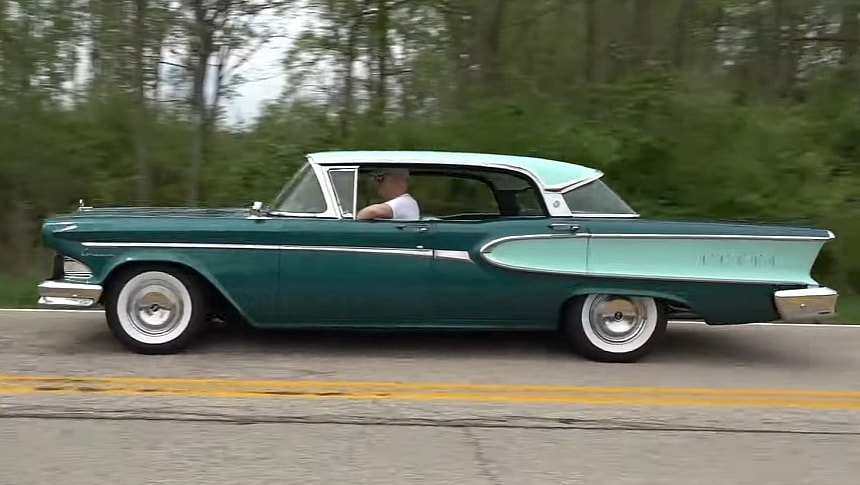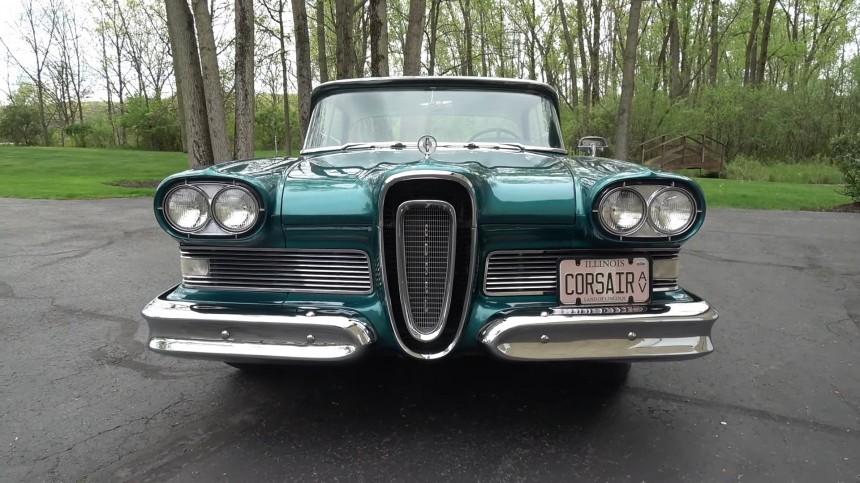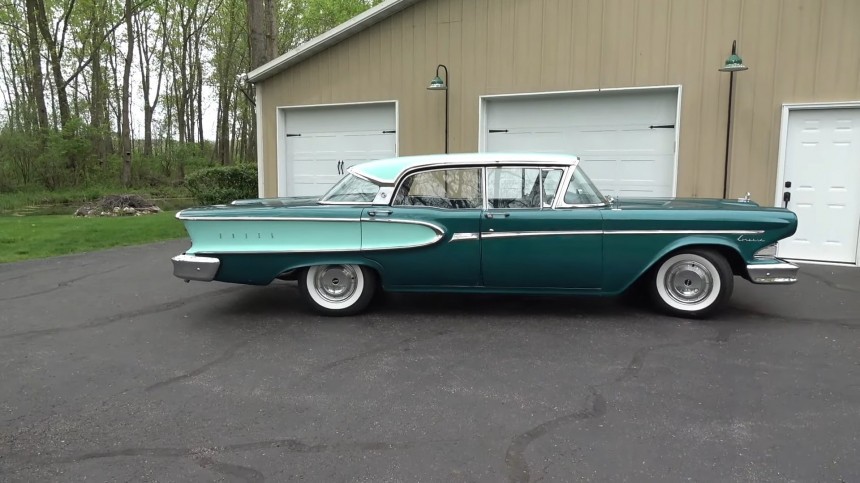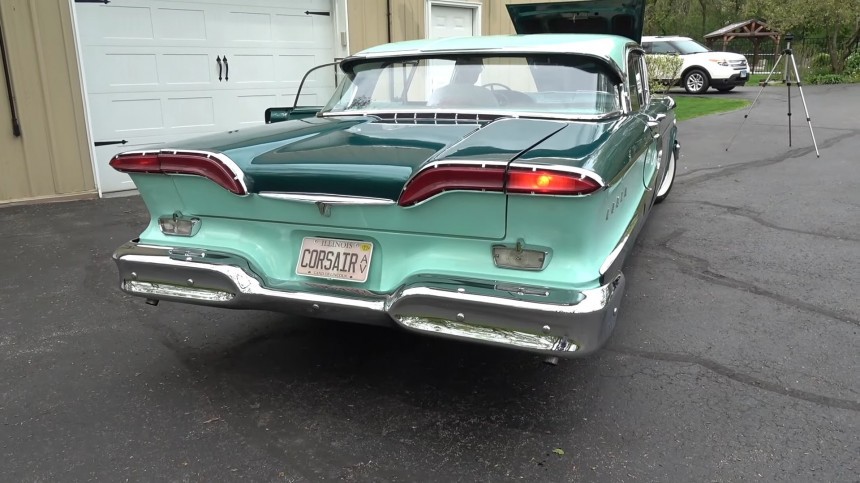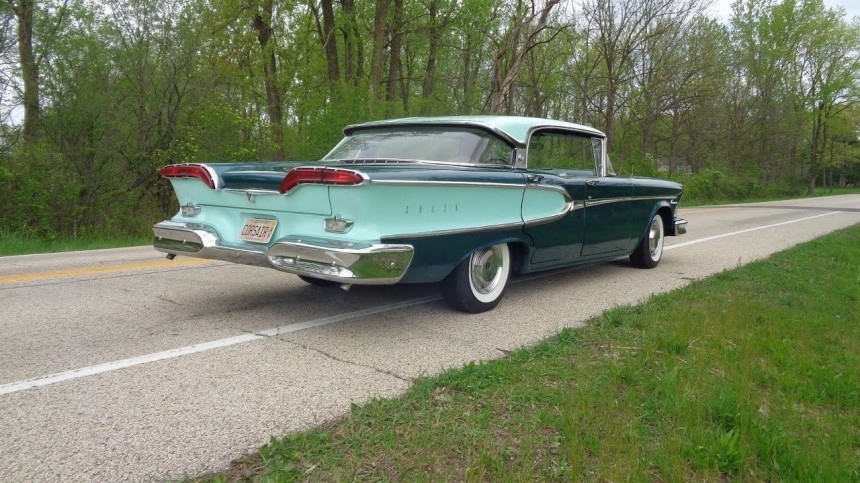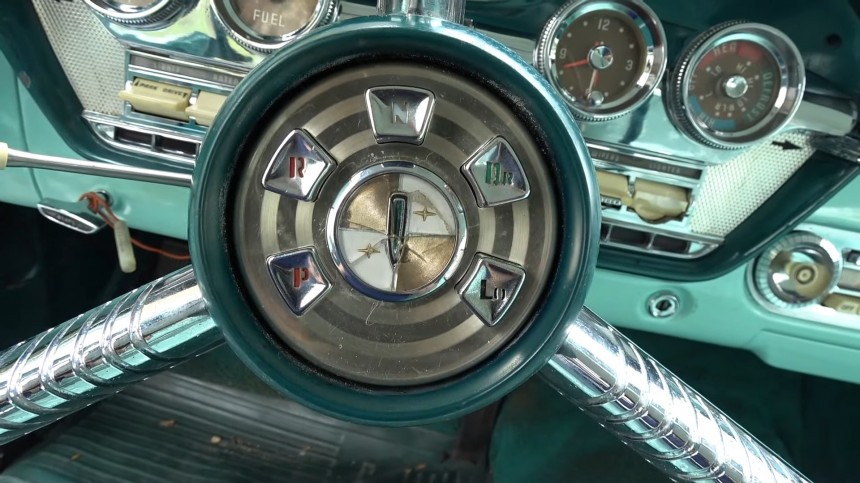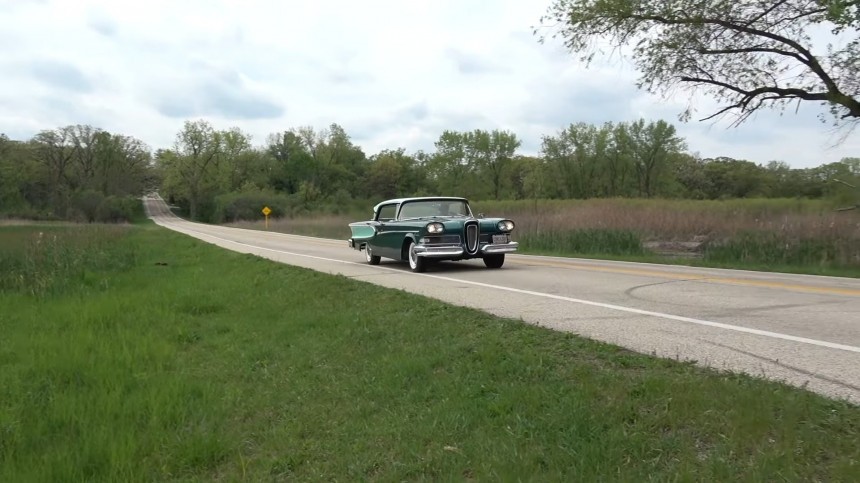In the late 1940s, Ford Motor Company concluded that a mid-priced automobile void hindered sales and pushed a significant portion of the market into a mass migration to other manufacturers. Long story short, a quarter-billion-dollar effort and a decade later, the newly formed Edsel division presented its first lineup of automobiles. It was the biggest flop in automobile history—by 1960, Edsel was gone forever.
Launched on September 4, 1957, the Edsel automobile brand from Ford was retired on November 19, 1959, precisely 807 days after its introduction. With a mere 118,287 units assembled over three model years, seven different models, and twenty body styles, the over-hyped brand fell short of expectations. It landed flat on its face, grenading FoMoCo’s financials like nothing else since the Great Depression.
With that relatively low production run, it’s perfectly reasonable to come across an Edsel automobile (irrespective of model year), even at car shows or other automotive events. However slim, the chances still exist, and among the estimated 6,000 examples left around today, good and great-condition survivors still exist.
The Edsel cars were born under an unlucky array of stars but from all the good intentions. Henry Ford II had plans for a medium-priced Ford product as far back as the late 40s, right when post-war production was switching to new models, ditching the 1941-1942 designs for good. However, the Korean War broke out, and Ford postponed its new car.
By 1955, the air was cleared, and Edsel (the division) caught shape. It should have offered Ford customers a choice similar to what Chevy loyalists had from Pontiac, Oldsmobile, or Buick, and Mopar-heads could get when they traded up from Plymouth to Dodge, De Soto, or Chrysler. Ford people had to jump from the base Ford straight to Mercury and Lincoln without an intermediate step. (I’ve omitted the Cadillac, Imperial, and Continental brands from each of the big three since luxury wasn’t a niche that could benefit from the carmakers’ lengths of the lineups below).
Ford threw in the Edsel – a new car division for a new car. The Deuce (Henry Ford II) asked for his new product to be recognizable ‘from a mile away’ and look like nothing else on sale at the time. The designers got that part right – the 1958 Edsel cars were unmistakable. However, for several reasons, they weren’t to everybody’s (or at least to the majority’s) taste.
Some of those had to do with the design – the first-year Edsel models radically differed from their competitors. The gap was so drastic that buyers got second, third, and many other thoughts. Acquired taste or not, the new cars were selling like hotcakes, as Ford had expected (extensive – and expensive – research indicated a 400,000-unit yearly sales volume high bubble, achievable within a decade).
A major flaw in Ford's logic was the imminent Eisenhower recession of 1958 when sales nosedived spectacularly across the board. Initial prediction put the Edsel at 200,000 units sold for that year. Still, the economic downturn returned a third of that figure. 68,045 automobiles bearing the ‘horse collar’ grille left the factories far below what dealerships expected.
Despite the unprecedented build-up for the launch and the advertised features of the new cars, several issues plagued sales big time (on top of the already dreadful recession). Since the all-new Edsels were assembled in Ford and Mercury plants rather than in separate facilities, intrinsic mishaps shot the new brand in the foot.
On the assembly line, Edsels were slotted between Fords or Mercurys. The workers’ routine of putting together one or the other sometimes caused an Edsel to come out at the other end with parts missing or not fitting correctly. Supply chain issues (yes, this isn’t a 2020s-era situation) also held back production, and many of the early-build models arrived at dealers with missing parts.
Since the dealerships weren’t properly tooled to complete the job, finishing the build wasn’t easy. Customers weren’t happy to learn that their cars were in the dealer’s warehouse, yet they couldn’t drive away in them because the automobiles hadn’t been fully assembled. That seriously stained the Edsel image, and orders began running dry. Dealers, in turn, revoked their franchises, which fended off even more prospects, and this downward spiral turned into a snowball of unstoppable proportions.
Advertised as mid-priced, the Edsels trotted well into Mercury territory, particularly the ‘Senior’ – the Citation and Corsair built on a Mercury platform. At the other, presumably more budget-friendly end, a Ford frame was the foundation of the Ranger, Pacer, and station wagon trio (Bermuda, Villager, and Roundup), putting the cars on the same level as readily available Fords.
Ford enthusiasts were biased toward existing brands (the new nameplate had no fan base to rely on, so there was no previous ownership loyalty to appeal to. Add in the funny names, and we have a pretty accurate picture of why the Edsel was a spectacular failure of corporate proportions. And let’s not open the topic of the nomenclature.
On September 4, 1957, some 2.5 million Americans visited Edsel showrooms for a first look at the heavily advertised automobile. Unfortunately, attention was all most of them paid, despite the car’s undeniable attractions. For instance, the Teletouch push-button transmission was something the United States of Automobile had not seen before.
While shifting gears at the push of a button wasn’t a novelty (Chrysler offered a similar feature in the period), the buttons' placement in the middle of the steering wheel hub made an impression. The two-speed gearbox had five buttons planted on the column, and the buttons were always level (they didn’t change position as the driver turned the wheel). A set of planetary gears allowed for the commands to remain stationary, but there was a hidden flaw that many buyers complained about.
The design was innovative, but the engineering wasn’t time-proven, and sometimes the gearbox got stuck. The workaround for this was quite easy: the driver had to go through Neutral instead of pushing the desired button for whatever situation. In fact, why don’t you play the video below and watch Dave ‘Buz’ Kirkel, the proud second owner of a 1958 Edsel Corsair four-door sedan, demonstrate the fail-safe operation of the Teletouch transmission?
Dave purchased the car a couple of months ago from its original owner (a long-time friend of Buz) and added the rarity to his impressive collection of American classics (he also owns a 1959 and a 1960 Edsel, among other cars). Apart from the buttons on the steering wheel (something we’re very accustomed to nowadays but was space-tech 67 years ago), the rotating speedometer is another cool feature. It’s easy to mistake it for a compass, but the actual bearing-pointing gadget sits on the dash to the left of the speedo.
Buz’s car is in excellent shape and has had a very good life (even though the 47,186 miles / 75,938 km on the clock might be 147k / 236,500 metric clicks). In a move similar to Buick's, Edsel advertised its engines by cubic-inch displacement and torque output. Hence, the ‘475’ on the white valvetrain covers represents just as many pound-feet of the 410-cubic-inch V8 (6.7 liters).
345 hp and 475 lb-ft (350 PS, 644 Nm) was quite a lot for 1957—but then again, Edsel aimed at the jackpot by all possible means. The public’s expectations proved too high for what the car could live up to, and sales quickly proved it. For the 1959 model year, Edsel sold 47,396 vehicles, and the production for 1960 totaled 2,846 (built between September and November 1959).
The Corsair we see in Lou Costabile’s video is one of the 5,880 four-door hardtops built for the model year for the domestic market (6,355 Corsairs were assembled in total, including Canadian production). Overall, the model was manufactured in 9,975 units (two-door hardtop was the other body style available, with 3,312 made for the USA and 320 for Canada).
All in all, just 118,287 Edsels were ever produced (110,847 in America, 7,440 north of the border) before FoMoCo threw in the towel and instead focused on another market segment, the compacts from which the fabulous Mustang spawned just four years later.
With that relatively low production run, it’s perfectly reasonable to come across an Edsel automobile (irrespective of model year), even at car shows or other automotive events. However slim, the chances still exist, and among the estimated 6,000 examples left around today, good and great-condition survivors still exist.
The Edsel cars were born under an unlucky array of stars but from all the good intentions. Henry Ford II had plans for a medium-priced Ford product as far back as the late 40s, right when post-war production was switching to new models, ditching the 1941-1942 designs for good. However, the Korean War broke out, and Ford postponed its new car.
Ford threw in the Edsel – a new car division for a new car. The Deuce (Henry Ford II) asked for his new product to be recognizable ‘from a mile away’ and look like nothing else on sale at the time. The designers got that part right – the 1958 Edsel cars were unmistakable. However, for several reasons, they weren’t to everybody’s (or at least to the majority’s) taste.
Some of those had to do with the design – the first-year Edsel models radically differed from their competitors. The gap was so drastic that buyers got second, third, and many other thoughts. Acquired taste or not, the new cars were selling like hotcakes, as Ford had expected (extensive – and expensive – research indicated a 400,000-unit yearly sales volume high bubble, achievable within a decade).
Despite the unprecedented build-up for the launch and the advertised features of the new cars, several issues plagued sales big time (on top of the already dreadful recession). Since the all-new Edsels were assembled in Ford and Mercury plants rather than in separate facilities, intrinsic mishaps shot the new brand in the foot.
On the assembly line, Edsels were slotted between Fords or Mercurys. The workers’ routine of putting together one or the other sometimes caused an Edsel to come out at the other end with parts missing or not fitting correctly. Supply chain issues (yes, this isn’t a 2020s-era situation) also held back production, and many of the early-build models arrived at dealers with missing parts.
Advertised as mid-priced, the Edsels trotted well into Mercury territory, particularly the ‘Senior’ – the Citation and Corsair built on a Mercury platform. At the other, presumably more budget-friendly end, a Ford frame was the foundation of the Ranger, Pacer, and station wagon trio (Bermuda, Villager, and Roundup), putting the cars on the same level as readily available Fords.
Ford enthusiasts were biased toward existing brands (the new nameplate had no fan base to rely on, so there was no previous ownership loyalty to appeal to. Add in the funny names, and we have a pretty accurate picture of why the Edsel was a spectacular failure of corporate proportions. And let’s not open the topic of the nomenclature.
While shifting gears at the push of a button wasn’t a novelty (Chrysler offered a similar feature in the period), the buttons' placement in the middle of the steering wheel hub made an impression. The two-speed gearbox had five buttons planted on the column, and the buttons were always level (they didn’t change position as the driver turned the wheel). A set of planetary gears allowed for the commands to remain stationary, but there was a hidden flaw that many buyers complained about.
The design was innovative, but the engineering wasn’t time-proven, and sometimes the gearbox got stuck. The workaround for this was quite easy: the driver had to go through Neutral instead of pushing the desired button for whatever situation. In fact, why don’t you play the video below and watch Dave ‘Buz’ Kirkel, the proud second owner of a 1958 Edsel Corsair four-door sedan, demonstrate the fail-safe operation of the Teletouch transmission?
Buz’s car is in excellent shape and has had a very good life (even though the 47,186 miles / 75,938 km on the clock might be 147k / 236,500 metric clicks). In a move similar to Buick's, Edsel advertised its engines by cubic-inch displacement and torque output. Hence, the ‘475’ on the white valvetrain covers represents just as many pound-feet of the 410-cubic-inch V8 (6.7 liters).
345 hp and 475 lb-ft (350 PS, 644 Nm) was quite a lot for 1957—but then again, Edsel aimed at the jackpot by all possible means. The public’s expectations proved too high for what the car could live up to, and sales quickly proved it. For the 1959 model year, Edsel sold 47,396 vehicles, and the production for 1960 totaled 2,846 (built between September and November 1959).
All in all, just 118,287 Edsels were ever produced (110,847 in America, 7,440 north of the border) before FoMoCo threw in the towel and instead focused on another market segment, the compacts from which the fabulous Mustang spawned just four years later.
